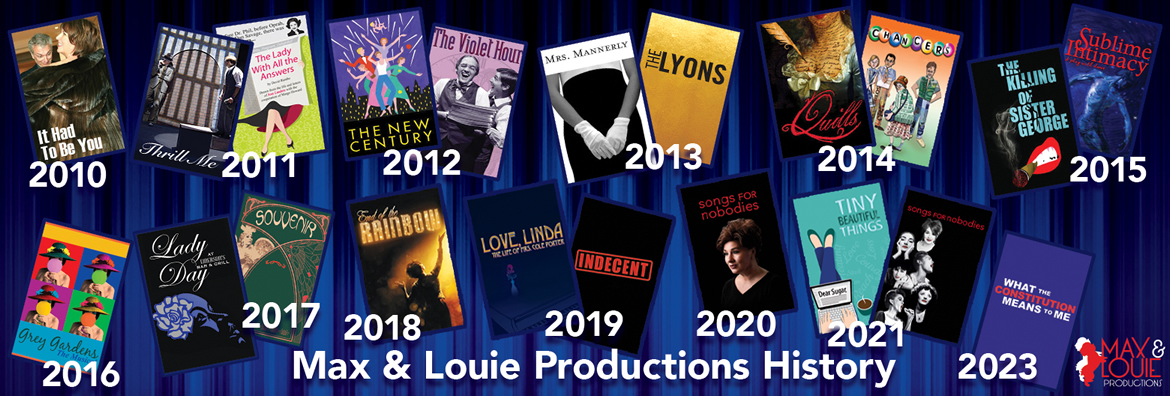The Killing of Sister George
Website Review
Snoop MK – Snoop’s Theatre Thoughts, July 16, 2015
Max & Louie’s “Sister George” Is a Sharp, Still Relevant Character Study
What a difference 50 years makes. The Killing of Sister George apparently caused quite a scandal when it debuted in 1965, due to its then-daring subject matter. Today, the play isn’t as shocking as it would have been half a century ago, but it’s still relevant in many ways. In fact, there are issues in this play that are probably more noticable now because of the lack of “scandal”. As presented by Max & Louie Productions, it’s an ideally cast production with a colorful 1960’s aesthetic and sharp, incisive humor.
The title of the play refers to June Buckridge (Lavonne Byers), an actress in a BBC radio drama who is so invested in her character, the moped-riding small-town nurse Sister George, that her friends actually call her “George”. She also frequently talks about the characters on the show as if they’re real. George shares a flat with the younger, seemingly childlike Alice “Childie” McNaught (Shannon Nara). The two are obviously romantically involved, although that’s not explicitly stated. George is growing increasingly insecure because she thinks her character on the show may be killed off, and she’s also extremely jealous and possessive of Childie, who she apparently is afraid will cheat on her with a man. When one of the BBC executives, the prim and scheming Mrs. Mercy Croft (Erin Kelley) comes to call, George is sure that her days on the show are numbered, and Childie is concerned about her own security in various ways. Their volatile relationship is witnessed by their neighbor, the good-natured self-professed psychic Madame Xenia (Cooper Shaw), who seems to genuinely like George and distrust Childie.
The show is, appropriately, not updated for setting. It’s very much of a 1960s sensibility, and so the setting and costumes are all appropriately in-period. The production values are meticulously detailed, particularly in the costumes, designed by Bess Moynihan. Each character’s costumes reflect their personality with precision, from George’s dowdy attire, to Mrs. Mercy Croft’s severe, chic suits and Madame Xenia’s more colorful and eccentric garb. Childie’s outfits are a highlight, representing the mod 60s styles with wild, colorful patterns and stylish accessories. Dunsi Dai’s detailed set is suitably appointed to suggest the era, as well. There’s also excellent sound design by Michael B. Perkins, and an entertaining representation of George’s radio show, Applehurst.
It was the same-sex relationship aspects of the show that apparently caused such an outrage 50 years ago, although now that just plays as a matter of fact. Actually, I wonder if the other issues represented in the play have been brought into sharper focus simply because the shock value isn’t as apparent anymore. It’s still a caustic, dark comedy portraying an extremely dysfunctional relationship and characters who, for the most part, aren’t easy to sympathize with. It seems everyone has her own agenda, and the machinations just get more and more obvious as the play goes along. Among the issues dealt with are those of personal identity, job security, age vs. youth, and art vs. marketability in the entertainment industry. The very nature of and motivations for relationships and friendship is also explored, as are the consequences of actors’ identifying too closely with their roles. Throughout, the tone is one of sarcastic, biting humor as well as some forays into despair.
Byers as George is a strong anchor to this superb cast. With a commanding presence and brisk manner, she presents George’s authoritarian nature, tempering it with a sense of obvious vulnerability, as well. She’s well-matched by Nara as the deceptively childlike Childie, who seems fairly innocuous at first but becomes increasing complex as the story unfolds. She and Byers have strong chemistry as a bickering pair, with clear affection as well as suspicion, weariness, and strong hints of fear. Their “Laurel and Hardy” routine in Act 2 is a memorable tragicomic moment. Kelley also gives a memorable performance, lending a palpable air of menace to Mrs. Mercy’s outwardly polite and cheerful manner, and Shaw is warm and engaging as the play’s most likable character and possibly George’s only real friend, Madame Xenia. All four performers work together well, maintaining the sense of pacing and energy that this show requires.
I’m impressed by the overall authenticity of this production, set in London in the 1960s. The accents are very well done, and the sense of time and place is very believable. It’s a play full of well-drawn characters and challenging situations, with suitably memorable performances. Even though its premise is not as shocking as it would have been 50 yeears ago, this production still feels current and challenging in ways that may not have been as apparent in 1965. It’s an incisive and sometimes brutal character study, making for an intense and thought-provoking theatrical experience.
